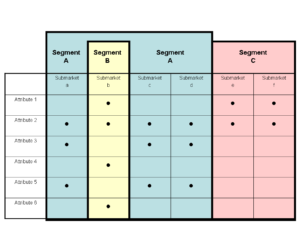 Why is this important? Adapting a product for international markets requires checking your assumptions about the current product definition. If you know why you are doing something today for your current market, it will be easier to check if that will still be true in the new market. This way, the internationalization team will be able to adapt the existing product to the new market in a systematic way. Having a process for internationalizing a product saves both time and cost.
Why is this important? Adapting a product for international markets requires checking your assumptions about the current product definition. If you know why you are doing something today for your current market, it will be easier to check if that will still be true in the new market. This way, the internationalization team will be able to adapt the existing product to the new market in a systematic way. Having a process for internationalizing a product saves both time and cost.
Segmentation
How do you define your current market segments? How do you group customers? By industry, sector, geography, job title, age? What are the unique challenges faced by each segment?
Use Cases
A use case is a specific way that customers get value from your product. Why do your current customers use your product? What problems are they trying to solve? Key use cases should be fully documented, including steps the customer takes to complete the use case. Many use cases are specific to a particular segment.

